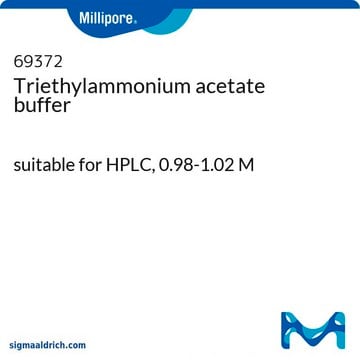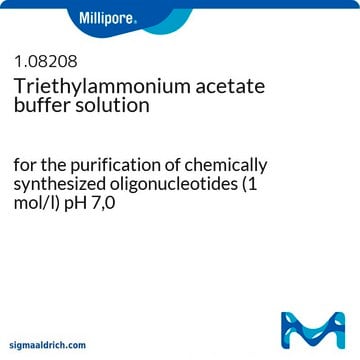If this product has an expiration or retest date, it will be shown on the Certificate of Analysis (COA, CofA). If there is no retest or expiration date listed on the product's COA, we do not have suitable stability data to determine a shelf life. For these products, the only date on the COA will be the release date; a retest, expiration, or use-by-date will not be displayed.
For all products, we recommend handling per defined conditions as printed in our product literature and website product descriptions. We recommend that products should be routinely inspected by customers to ensure they perform as expected.
For products without retest or expiration dates, our standard warranty of 1 year from the date of shipment is applicable.
For more information, please refer to the Product Dating Information document: https://www.sigmaaldrich.com/deepweb/assets/sigmaaldrich/marketing/global/documents/449/386/product-dating-information-mk.pdf
90358
Triethylammonium acetate buffer
volatile buffer, ~1.0 M in H2O
Synonym(s):
Triethylammonium acetate buffer, Buffer solution 1 M pH 7.0 (volatile)
About This Item
Recommended Products
Quality Level
Assay
0.95—1.05 mol
form
liquid
shelf life
limited shelf life, expiry date on the label
storage condition
dry at room temperature
concentration
1 M
~1.0 M in H2O
technique(s)
electrophoresis: suitable
color
colorless
refractive index
n20/D 1.357
pH
7.0
6.1
density
1.002 g/mL at 20 °C
suitability
suitable for chromatography
suitable for protein modification
suitable for separation of small nucleic acid fragments
application(s)
detection
diagnostic assay manufacturing
life science and biopharma
sample preparation
storage temp.
2-8°C
InChI
1S/C6H15N.C2H4O2/c1-4-7(5-2)6-3;1-2(3)4/h4-6H2,1-3H3;1H3,(H,3,4)
InChI key
AVBGNFCMKJOFIN-UHFFFAOYSA-N
Related Categories
General description
Application
Features and Benefits
- Suitable for Biological and Biochemical Research
- Ready available solution reduce the need for preparation time
Other Notes
Storage Class Code
12 - Non Combustible Liquids
WGK
WGK 3
Flash Point(F)
Not applicable
Flash Point(C)
Not applicable
Personal Protective Equipment
Choose from one of the most recent versions:
Already Own This Product?
Find documentation for the products that you have recently purchased in the Document Library.
Customers Also Viewed
Articles
Chromolith® RP-18e columns optimize Oligo Standard 6 separation with varied flow rates and ion-pairing reagent evaluation.
Chromolith® RP-18e columns optimize Oligo Standard 6 separation with varied flow rates and ion-pairing reagent evaluation.
Chromolith® RP-18e columns optimize Oligo Standard 6 separation with varied flow rates and ion-pairing reagent evaluation.
Chromolith® RP-18e columns optimize Oligo Standard 6 separation with varied flow rates and ion-pairing reagent evaluation.
-
How can I determine the shelf life / expiration / retest date of this product?
1 answer-
Helpful?
-
-
How is shipping temperature determined? And how is it related to the product storage temperature?
1 answer-
Products may be shipped at a different temperature than the recommended long-term storage temperature. If the product quality is sensitive to short-term exposure to conditions other than the recommended long-term storage, it will be shipped on wet or dry-ice. If the product quality is NOT affected by short-term exposure to conditions other than the recommended long-term storage, it will be shipped at ambient temperature. As shipping routes are configured for minimum transit times, shipping at ambient temperature helps control shipping costs for our customers. For more information, please refer to the Storage and Transport Conditions document: https://www.sigmaaldrich.com/deepweb/assets/sigmaaldrich/marketing/global/documents/316/622/storage-transport-conditions-mk.pdf
Helpful?
-
-
Hi, I want to purchase triethylammonium acetate solid, but it's not available. I wonder if this TEAA buffer made of pure TEAA, or is there anything else added to adjust the pH? Please let me know about other chemical content in this product. Thank you.
1 answer-
This product is a 1M solution in water. Triethylammonium acetate is a mixture of triethylamine and acetic acid. The purity of the specific starting materials is not reported. However, the molarity is confirmed and reported in the lot specific Certificate of Analysis. Please see the link below to review a sample or lot specific Certificate:
https://www.sigmaaldrich.com/product/sigma/90358#product-documentationHelpful?
-
Active Filters
Our team of scientists has experience in all areas of research including Life Science, Material Science, Chemical Synthesis, Chromatography, Analytical and many others.
Contact Technical Service











